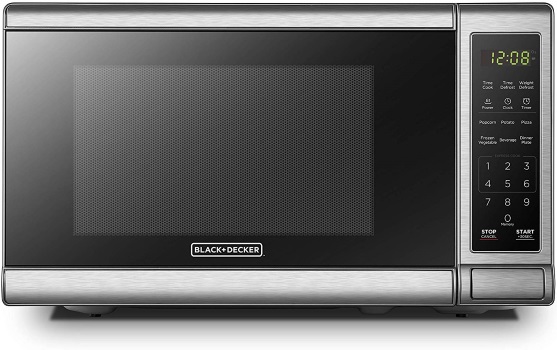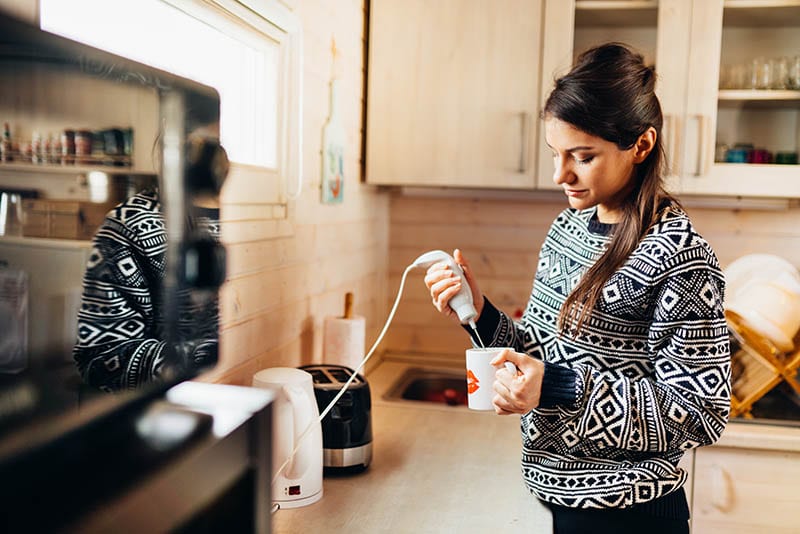
Delicious, perfectly frothed milk is undeniably enjoyable. And the experience of drinking fluffy, cloud-like milk mixed with robust espresso? Unbeatable. But buying lattes at your favorite café can quickly drain your wallet.
Luckily, you can make delicious foam at home using the equipment you already have. To show you how here is a list of nine different ways to froth milk at home. Enjoy your homemade lattes and cappuccinos!

Top 9 Ways To Froth Milk at Home
1. Froth with Heat (Microwave)
For the first frothing technique, one of the crucial elements we need is heat, particularly, a microwave. Milk always froths best with heat, and the microwave is a quick way to bring sufficient heat into the milk, enabling it to hold its form much better.

Froth is milk filled with air bubbles. It’s easy to fill milk with bubbles. Give any drink to a child, and it will have more air forced into it than a barista’s milk frother. But you rarely see their milk bottles come back frothy like a cafe’s latte. The missing ingredient is heat. Put air-filled milk into the microwave, and the froth forms and sets much more effectively into the desired frothy texture.
2. Froth with a Jar
It may seem funny that a jar is the second item on our list, but it’s surprisingly one of the best ways to produce milk with a soft, light texture. Fill a jar no more than two-thirds full, put a lid on it, and get shaking. This is also a great way to incorporate some family time into your coffee craving too; simply ask your child or a family member’s child to join in the fun and get shaking with you.

The more you shake, the more air will get into the milk, and the frothier it will be. Once you’re satisfied shaking the jar, or your kids have finished their aerating competition, take the lid off and put it in the microwave for around thirty seconds. This will depend on your microwave power rating, but thirty seconds is pretty standard. Now, all that air inside the milk mixed with a bit of heat bubbles up a nice frothy texture ready for your favorite hot drink.
3. French Press
The finer the bubbles, the softer and fluffier the milk will become. A French press is made with layers of incredibly fine mesh, and the holes are so tiny that it stops micro-grains of coffee from escaping through them. This is perfect for milk frothing.

Put some milk that’s just been heated in the microwave or a pot into the French press. Make sure it’s no more than half full. Then give your arm a workout by pressing the utensils up and down continuously until you’re happy with the texture. The faster and longer you go, the nicer a froth it will be, but it doesn’t take very long to produce a smooth and light consistency.
4. Loose Tea Infuser Mix
A loose tea infuser is an excellent substitute for tea bags. It’s a ball-shaped utensil that splits open by someone gripping its spring-loaded handle. If you have one of these, it can be used effectively to froth a fresh cup of milk. In fact, it works with any kind of milk, but to different consistencies depending on the kind you choose.

The milk can be heated before or after, but to infuse it with air, you simply whisk the utensil around until it’s frothy. This way requires more work than others, but the results are excellent. Similar to the French press, there are many fine holes throughout the loose tea infuser, which breaks up the milk and allows air to infiltrate much more of it than with other methods.
If you whisk the milk before putting it into the microwave, you won’t see as much froth before it goes into the microwave as you do with the jar technique. So, it’s best to heat the milk beforehand.
5. Pouring Method
This method is a little tedious, as it requires the most patience and can be messy. However, it’s surprisingly effective if you persevere with it. What you need is a tea strainer similar to the loose tea infuser, only larger and bowl-shaped, as opposed to the ball-shaped infuser. You set the strainer inside a cup hooked over its edge like it’s designed to do.
With a second cup of heated milk, you then pour it through the tea strainer into the first cup. Once the milk is transferred through the strainer into the first cup, switch the strainer over to the now-empty second cup and pour the milk over it again. Continue this process, switching the strainer between the two cups, and with enough pours, you will have wonderful frothy milk.
It works better than loose tea infuser mixing. As the milk passes through the strainer, it is filled with much more air during its travel down into the cup, as opposed to the infuser forcing air from above down into it. However, it can be a slow process and tends to be messy unless you patiently shake the excess milk off carefully in the cup before switching to the next cup.
6. Use a Baking Mixer
Using a baking mixer may seem like a better solution to get air into the milk quickly. Getting electrical power involved to do the hard work for us is always desirable. This is true in part; there is no way a hand can compete with the speed and constancy of a baking mixer’s power, but most blenders only have a few large blades, which lack the ability to create the finest bubbles necessary for pristine frothy milk.

Nonetheless, it’s a fast and easy way to blend lots of milk if you have some friends over. To froth milk with a baking mixer, simply heat the milk, put it into the mixing bowl, and turn the machine on like you would for mixing some baking ingredients. It’s not excellent frothy milk, but it’s better than no froth.
7. Blending Machine
The blending machine is also a fast option to froth a cup of milk. Make sure the milk is nice and warm for the froth to set, don’t overfill the blending machine, and turn it on to blend yourself a frothy cup of milk. Again, it’s not the best froth you can produce in a kitchen, but it’s a quick, clean way of producing it.
8. Hand-Held Soup Blender

A hand-held soup blender is a blender turned upside down and inside out. The blades are at the bottom and outside of the soup blender, where the typical blender has blades inside the machine at the top of the main base area where the cup or jug fastens onto it.
It has about as much power as a blender too, which can be catastrophic in a kitchen with a cup of milk if you’re not careful. Milk has a much lighter consistency than soup, so it can spray the milk out of the cup all over the kitchen.
However, it produces a similar result to the blending machine. If you have one at home, warm your milk and give it a blitz with the hand-held soup blender, and you’ll have frothy milk in no time.
9. Whisking by Hand

This last option is one we only recommend if you’re desperate. It’s similar to the first lot of ways to froth milk requiring you to create the froth manually, only it doesn’t produce the fine bubbles through it. It can be a tiresome option and doesn’t produce the best kind of frothy milk.
Yet sometimes beggars can’t be choosers, and in this case, a whisk is a good option to produce frothy milk when you’re without other options. Heat the milk for about thirty seconds in the microwave, then get whisking, and you should eventually produce some frothed milk for your coffee.

Frothing Milk: Final Thoughts
There are a few challenging ways to froth milk at home, but some of them are very easy and produce a fine quality froth. However, all of them are effective ways to bring home your favorite coffee experience. So why not give one of these methods a try? We recommend trying to froth with a jar first; it’s very easy and surprisingly effective. You’ll be enjoying a perfectly frothed latte in no time.
RELATED READ: What are the 21 types of espresso drinks?
Featured image credit: skeeze, Pixabay















